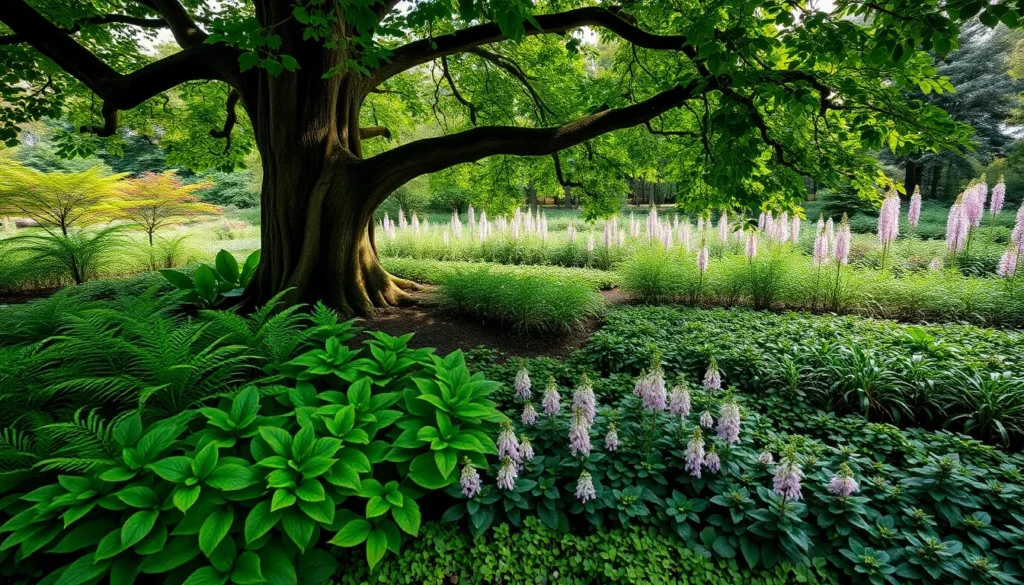We’ve all faced that frustrating challenge of trying to grow beautiful plants in the shadowy spaces beneath our favorite trees. Those bare patches of dirt or struggling grass under towering oaks and maples don’t have to remain barren wastelands in our gardens.
The secret lies in understanding that shade doesn’t mean lifeless – it means opportunity. Countless stunning plants actually thrive in these low-light conditions, transforming what many consider problem areas into lush, vibrant garden features that’ll make your neighbors wonder how you achieved such gorgeous results.
From delicate ferns that dance in dappled sunlight to bold hostas that create dramatic foliage displays, we’re about to show you how to turn those challenging under-tree spaces into some of the most enchanting spots in your industry. You’ll discover which plants not only survive but flourish in shade while competing with tree roots for nutrients.
Best Shade-Loving Ground Covers for Under Trees
These remarkable plants create living carpets that transform barren spaces beneath trees into lush, verdant landscapes. We’ve selected ground covers that not only tolerate challenging conditions but actually flourish in the deep shade and root competition found under mature trees.
Hostas: The Classic Shade Garden Staple
Hostas offer unmatched versatility with their stunning foliage variations and reliable performance in shaded areas. We recommend varieties like ‘Blue Angel’ for large spaces or ‘Mouse Ears’ for compact areas under smaller trees. These perennials develop extensive root systems that compete effectively with tree roots while producing heart shaped leaves in colors ranging from blue green to golden yellow.
Watering requirements stay minimal once hostas establish themselves, typically needing only one inch per week during dry periods. Most varieties reach maturity within three years and spread naturally to fill available space. Their seasonal interest extends beyond foliage as fragrant white or purple flower spikes emerge in summer, attracting beneficial pollinators to shaded garden areas.
Wild Ginger: Native Beauty That Thrives in Deep Shade
Wild ginger creates dense mats of kidney shaped leaves that suppress weeds naturally while requiring virtually no maintenance. We’ve observed this native plant thriving in conditions where other ground covers struggle, particularly in areas with heavy clay soil and deep shade cast by evergreen trees. The plant spreads through underground rhizomes, establishing colonies that can cover 20 to 30 square feet within five years.
Spring brings unique burgundy flowers that bloom close to the ground, though the glossy green foliage remains the primary attraction throughout the growing season. Wild ginger tolerates foot traffic better than most shade ground covers and stays evergreen in warmer climates. Deer consistently avoid this plant, making it perfect for areas where wildlife browsing presents challenges.
Pachysandra: Low-Maintenance Evergreen Carpet
Pachysandra forms dense evergreen mats that eliminate the need for mulching while providing year round color in shaded spaces. We’ve found this ground cover particularly effective under pine trees where acidic soil conditions favor its growth. The plant reaches 6 to 8 inches in height and spreads through underground stolons to create uniform coverage.
Establishment requires patience as pachysandra grows slowly during its first two years before accelerating to cover large areas. White flower clusters appear in early spring, followed by small white berries that persist through winter. This ground cover performs best in consistently moist soil and can tolerate temperatures down to negative 20 degrees Fahrenheit, making it suitable for northern climates where other options fail.
Colorful Flowering Plants for Under Trees
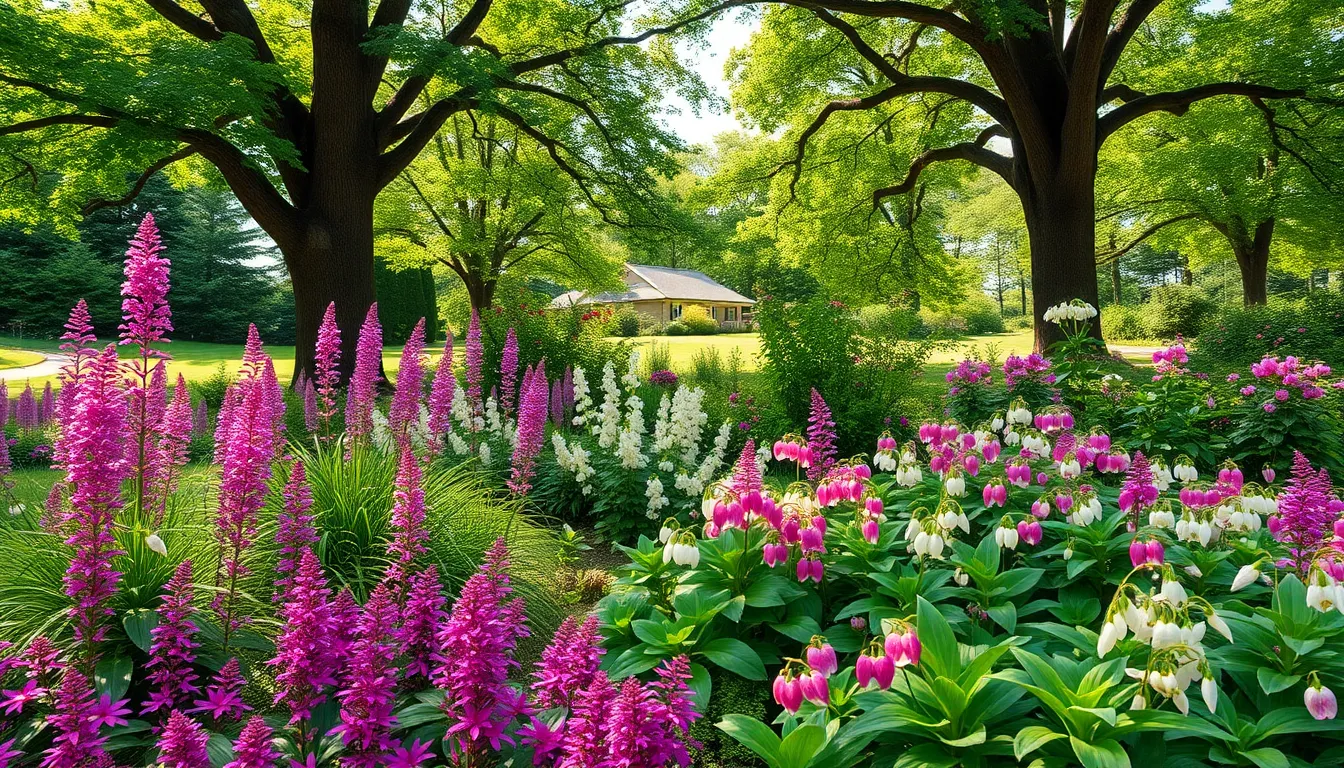
While ground covers create the foundation for shaded gardens, flowering plants bring vibrant color and seasonal interest to these challenging spaces. These colorful bloomers thrive in the dappled light beneath tree canopies and provide stunning displays throughout the growing season.
Astilbe: Feathery Blooms That Light Up Dark Spaces
Astilbe stands out as one of our favorite perennials for adding bright color to dark garden corners. These remarkable plants produce feathery, plume-like flowers in pink, white, red, and purple shades that create stunning visual impact in low-light areas. Blooming from spring to early summer, astilbe flowers provide the perfect contrast to the green backdrop of tree foliage above.
We recommend planting astilbe in moist, well-drained soil where it can receive partial to full shade conditions. The plant’s feathery texture adds incredible dimension to understory plantings, and its ability to thrive in tree root competition makes it an ideal choice for challenging shaded spaces. Once established, astilbe requires minimal maintenance while delivering maximum visual impact season after season.
Coral Bells: Vibrant Foliage and Delicate Flowers
Coral Bells offer us the best of both worlds with their spectacular colorful foliage and charming delicate flowers. These versatile perennials showcase leaves in deep purples, bright greens, and striking silver tones that provide year-round interest beneath tree canopies. During late spring, they produce airy flower spikes in pink or white that dance above the colorful foliage.
Thriving in partial to full shade conditions, Coral Bells adapt exceptionally well to root competition from overhead trees. Their evergreen or semi-evergreen nature ensures our shaded gardens maintain color and structure throughout winter months. We find these plants particularly effective when grouped together to create dramatic foliage displays that complement both deciduous and evergreen tree varieties.
Bleeding Heart: Heart-Shaped Blooms for Spring Interest
Bleeding Heart brings classic charm to our shaded gardens with its distinctive heart-shaped pink or white flowers. These enchanting perennials feature graceful arching stems that create elegant displays in spring, providing essential early season color before tree canopies fully leaf out. The unique flower shape adds whimsical character to woodland garden settings.
Perfect for partial to full shade locations, Bleeding Heart prefers moist, well-drained soil conditions similar to those found in natural forest environments. We appreciate how this plant goes dormant during summer months, making it ideal for areas with dappled light patterns that change throughout the season. Its spring blooming cycle perfectly complements the natural rhythm of deciduous trees overhead.
Ferns That Flourish Beneath Tree Canopies
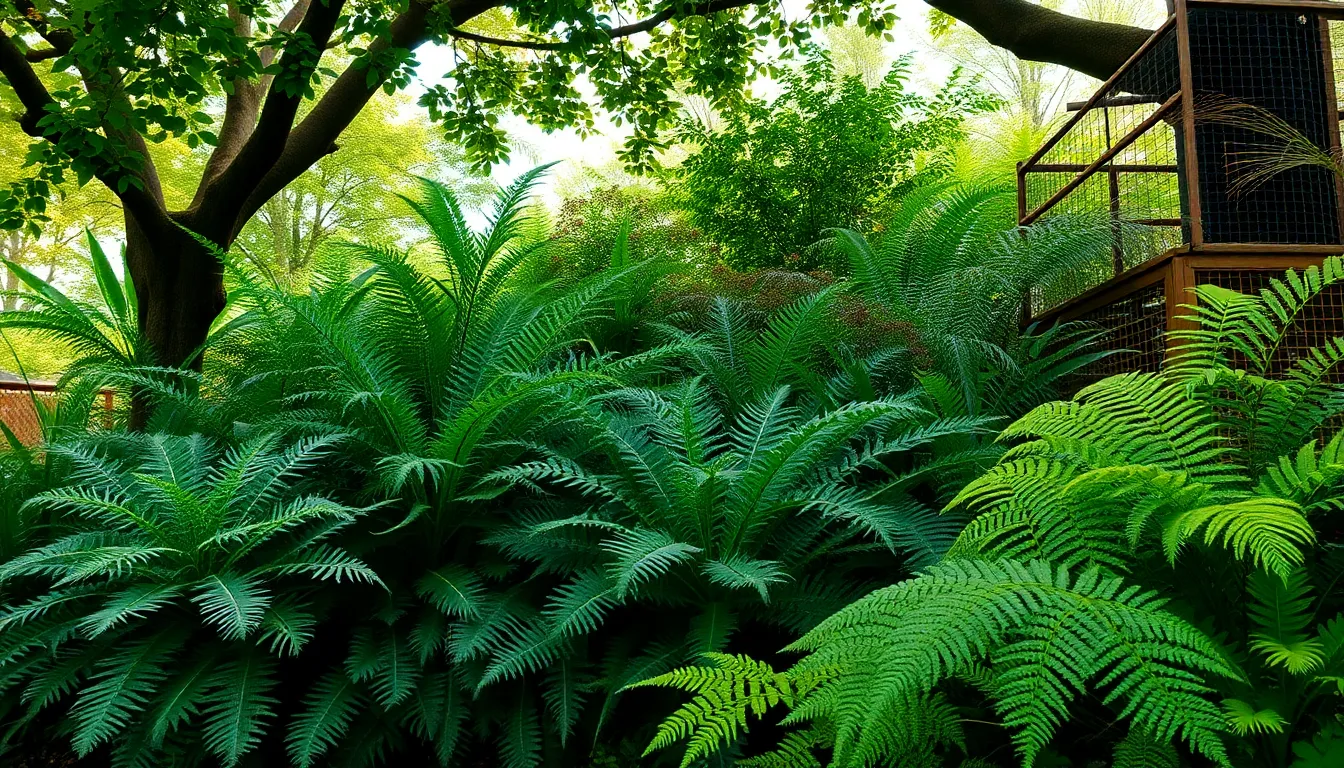
Ferns represent some of nature’s most resilient shade plants, perfectly adapted to thrive in the challenging conditions beneath tree canopies. We’ve found these ancient plants excel where others struggle, creating lush understory gardens that remain beautiful year round.
Christmas Fern: Year-Round Greenery for Shaded Areas
Christmas Fern provides exceptional evergreen coverage that maintains its vibrant texture throughout winter months. We recommend this hardy species for gardeners seeking reliable groundcover that won’t disappear when temperatures drop. Its leathery fronds stay green even in harsh winter conditions, offering visual interest when most other plants have gone dormant.
Polystichum acrostichoides adapts remarkably well to various soil conditions and moisture levels beneath established trees. Gardeners appreciate how this native fern requires minimal maintenance once established in shaded locations. We’ve observed Christmas Fern creating dense colonies that effectively suppress weeds while adding rich green texture to barren areas under tree canopies.
Japanese Painted Fern: Silvery Foliage for Elegant Appeal
Japanese Painted Fern transforms shaded spaces with its stunning silvery foliage accented by burgundy and green highlights. We consider Athyrium niponicum one of the most decorative ferns available for understory planting. Its elegant coloration brightens dark areas beneath trees where traditional flowering plants often struggle.
Moist, well drained soil conditions suit this ornamental fern perfectly, especially in partial to full shade environments. We’ve found Japanese Painted Fern pairs beautifully with other shade perennials like hostas and coral bells. Gardeners love how its refined aesthetic elevates the overall appearance of challenging planting areas beneath mature trees.
Cinnamon Fern: Native Option for Wet, Shady Spots
Cinnamon Fern excels in consistently moist environments where many other plants fail to establish successfully. We recommend Osmundastrum cinnamomeum for gardeners dealing with wet, shady locations that typically pose planting challenges. Its distinctive cinnamon colored fertile fronds emerge in spring, creating seasonal interest that adds visual appeal to understory gardens.
Native plant enthusiasts particularly value this fern’s natural adaptation to local growing conditions. We’ve observed Cinnamon Fern thriving in areas with heavy clay soil and poor drainage that would challenge most other shade plants. Its impressive size and dramatic texture make it an excellent focal point for larger spaces beneath tree canopies.
Bulbs and Perennials Perfect for Tree Shade
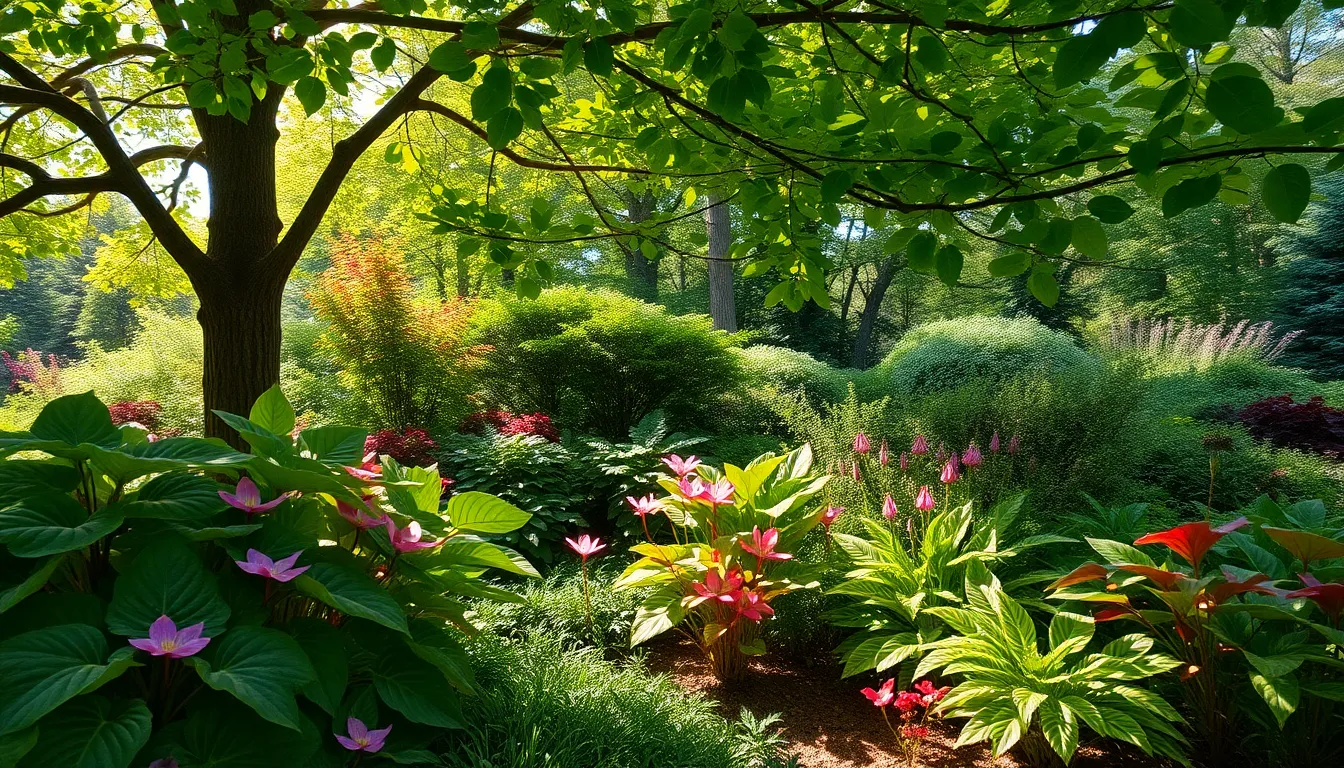
Moving beyond groundcovers and ferns, we can create stunning displays with bulbs and perennials that excel in the challenging conditions beneath tree canopies. These plants offer seasonal interest while competing successfully for water and nutrients with established tree roots.
Spring Ephemerals: Early Bloomers Before Leaf Canopy
Spring ephemerals provide the perfect solution for adding early season color under trees. These remarkable plants complete their entire growth cycle before trees fully leaf out, taking advantage of the brief window of increased sunlight filtering through bare branches.
Columbines like the Origami Blue & White variety brighten understory spaces with their delicate blooms and glossy foliage. Belgian Hybrid Orange Bush Lily adds bold color during this critical early season period. These plants strategically time their growth to maximize available light, then gracefully go dormant as tree canopies develop full shade coverage.
We love how spring ephemerals solve the timing challenge of tree shade gardening. They bloom when light levels are highest, then rest during the darkest months when other shade plants take center stage.
Caladium: Tropical Flair for Summer Shade Gardens
Caladiums transform summer shade gardens with their vibrant tropical foliage where many flowering plants struggle in low light conditions. These heat loving plants provide bold color and dramatic texture beneath tree canopies during the hottest months of the year.
Their heart shaped leaves display stunning combinations of pink, red, white, and green patterns that brighten even the deepest shade. Caladiums prefer moist, well drained soils and actually perform better in partial to full shade than in direct sunlight.
We recommend planting caladium bulbs after soil temperatures reach 70°F for best establishment. They’ll provide continuous color through summer until the first frost, making them ideal companions for hostas and other permanent shade perennials.
Lungwort: Spotted Leaves and Early Spring Flowers
Lungwort (Pulmonaria spp.) offers year round interest with its distinctive spotted foliage and early spring blooms that appear before most other perennials emerge. This classic woodland plant thrives in partial to full shade while preferring rich, moist soils that drain well.
The ornamental spotted leaves provide texture and visual interest long after the flowers fade, ranging from silver spotted to heavily mottled patterns. Early spring flowers bloom in shades of pink, blue, purple, and white, often changing color as they mature.
We find lungwort particularly valuable because it tolerates the dry conditions that often develop under mature trees once established. It forms attractive clumps that slowly spread without becoming invasive, making it perfect for naturalizing in woodland settings.
Shrubs That Complement Trees in Shaded Landscapes
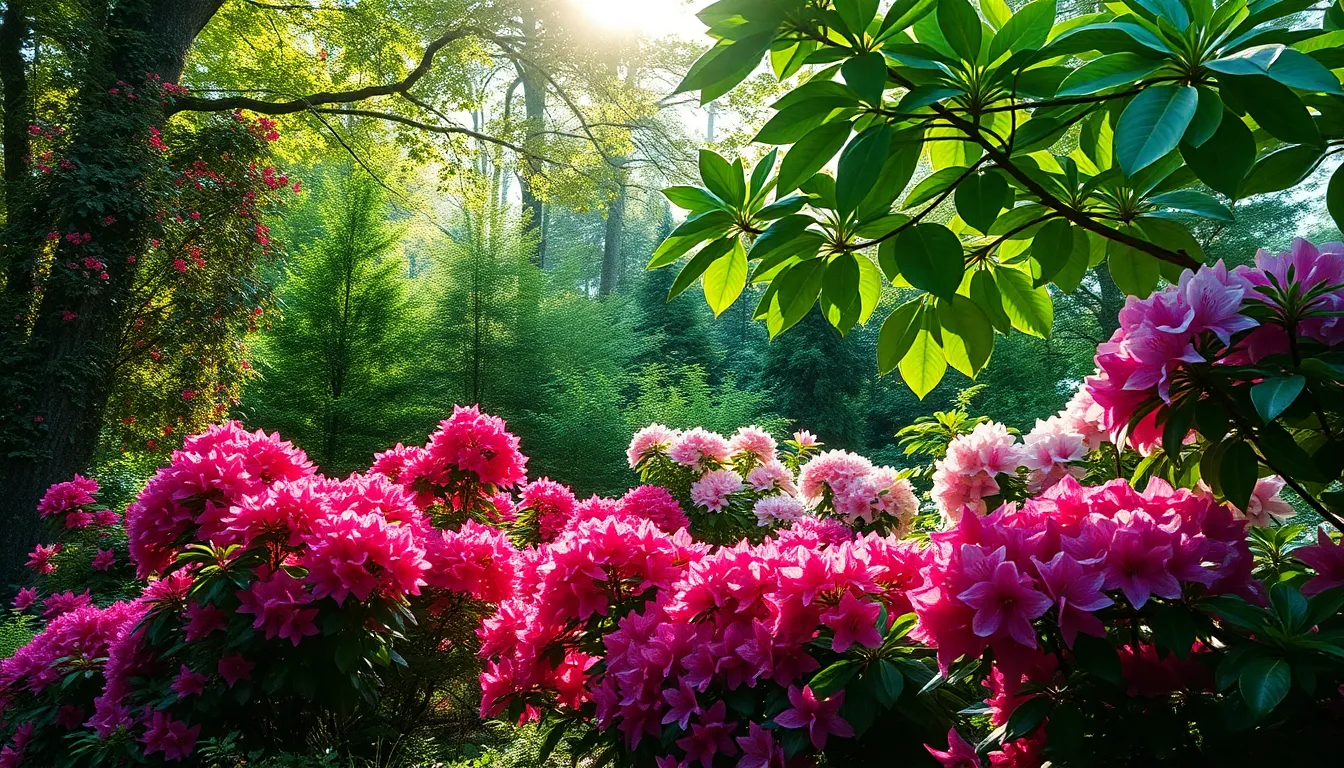
Moving beyond ground covers and smaller perennials, we’ll explore larger shrubs that create stunning vertical layers in your shaded garden spaces. These woody plants establish permanent structure while thriving in the competitive root environment beneath established trees.
Azaleas: Spring Flowering Shrubs for Acidic Soil
Azaleas transform shaded woodland areas into spectacular spring displays with their vibrant blooms in pink, white, red, and purple hues. These flowering shrubs thrive in acidic soil conditions naturally created by decomposing pine needles and oak leaves beneath trees. Partial to full shade provides the perfect growing environment, protecting their shallow root systems from harsh sunlight while maintaining consistent soil moisture.
Deciduous varieties like Flame Azalea and Korean Azalea offer brilliant fall foliage after their spring flower show. Evergreen types such as Kurume and Indica azaleas provide year round structure with glossy green leaves. Well drained, acidic soils with pH levels between 4.5 and 6.0 create optimal growing conditions for these understory performers.
Rhododendrons: Evergreen Structure with Showy Blooms
Rhododendrons bring substantial presence to shaded landscapes with their large, leathery leaves and impressive flower clusters that can span 12 inches across. These evergreen shrubs maintain visual interest throughout all seasons, offering glossy green foliage when not displaying their spectacular spring blooms. Deep shade tolerance makes them exceptional choices for areas directly beneath dense tree canopies where other plants struggle to survive.
Large leaf varieties like Rhododendron macrophyllum create bold textural contrast against delicate ferns and hostas. Compact cultivars such as ‘PJM’ and ‘Compact Pink’ work perfectly in smaller shaded spaces while still delivering impressive flower displays. Similar acidic soil requirements to azaleas mean these shrubs often thrive in the same woodland garden settings.
Oakleaf Hydrangea: Native Shrub with Four Season Interest
Oakleaf Hydrangea delivers unmatched seasonal performance in shaded areas with its distinctive oak shaped leaves, white summer flower clusters, and stunning fall color transformation. This native shrub adapts naturally to partial and full shade conditions while supporting local wildlife with nectar rich blooms that attract butterflies and beneficial insects. Multi season appeal includes exfoliating bark that provides winter interest after leaves drop.
Summer flower panicles emerge white in June and gradually fade to pink and burgundy tones, lasting well into fall for extended color displays. Fall foliage transitions from green to brilliant oranges, reds, and purples, rivaling any maple for autumn drama. Drought tolerance once established makes this native choice particularly valuable in competitive root zones where consistent watering proves challenging.
Essential Tips for Successfully Growing Plants Under Trees
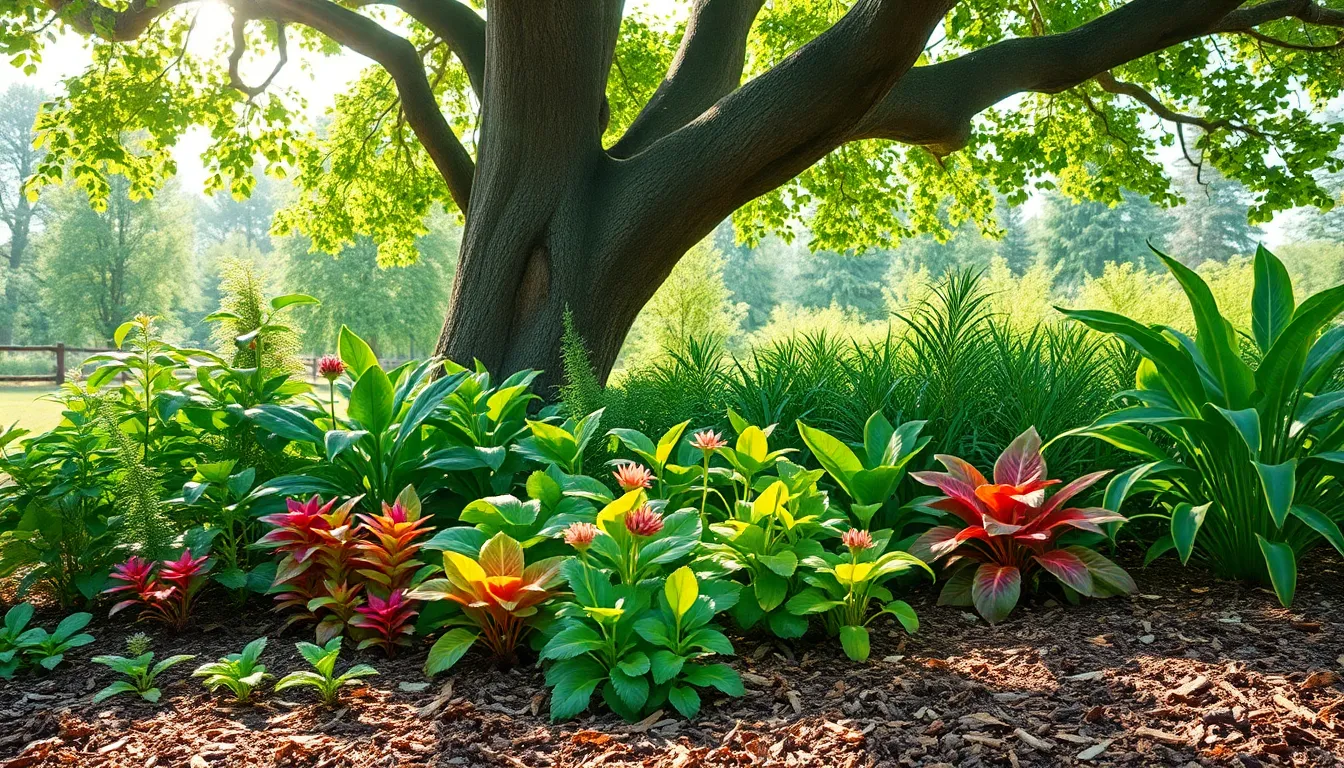
Creating a thriving understory garden requires mastering the unique challenges these spaces present. Success depends on understanding your exact site conditions and implementing proven strategies that work with nature rather than against it.
Understanding Root Competition and Soil Conditions
Tree roots create intense competition for both water and nutrients, making it essential to choose plants that can coexist rather than battle for resources. Extensive root systems extend far beyond the tree’s canopy, often competing directly with any understory plants we attempt to establish.
Soil conditions beneath trees differ dramatically from open garden spaces, particularly under conifers where needle drop creates acidic, dry conditions. We find that north-east sides of trees typically remain drier and more heavily shaded, while south-west areas offer better moisture retention and light penetration for successful planting.
Improving existing soil becomes crucial for establishing healthy understory plants that can compete effectively. Adding well-rotted organic matter such as garden compost, leaf mold, or farmyard manure enhances both soil fertility and structure, giving new plants the foundation they need to thrive.
Proper Watering Techniques for Tree Understory Plants
Generous watering during establishment proves critical for newly planted species, especially throughout their first 2 to 3 years beneath the tree canopy. We recommend deep, thorough watering sessions rather than frequent shallow applications to encourage strong root development.
Supplemental irrigation becomes necessary during dry spells and active growing seasons when tree roots compete most heavily for available moisture. Deep watering helps understory plants develop robust root systems capable of competing more effectively for water resources.
Consistent moisture monitoring ensures that our understory plants receive adequate hydration without overwatering, which can lead to root rot in the often-poor drainage conditions found under trees.
Mulching Strategies to Retain Moisture and Suppress Weeds
Organic mulches provide multiple benefits including soil moisture conservation, temperature regulation, and natural weed suppression that reduces competition for precious resources. We prefer shredded bark, leaf mold, or compost for their dual role as mulch and gradual soil improvement.
Deep mulch application each spring supports both establishment and long-term health of understory plants by maintaining consistent soil moisture and improving overall growing conditions. This practice proves especially valuable in areas where tree roots create challenging growing environments.
Strategic mulch placement around newly planted specimens creates protective zones that help young plants establish before they must compete fully with mature tree root systems.
Conclusion
We’ve shown you that the shaded spaces beneath your trees don’t have to remain empty or problematic. With the right plant selections and proper care techniques these areas can become some of the most stunning features in your industry.
From dense ground covers like pachysandra to vibrant flowering options like astilbe each plant we’ve discussed offers unique benefits for your understory garden. The key lies in working with your site’s natural conditions rather than fighting against them.
Remember that success comes from understanding your soil preparing it properly and choosing plants that actually thrive in competition with tree roots. Your patience during the establishment period will reward you with years of low-maintenance beauty that transforms those challenging shaded areas into garden treasures.
Frequently Asked Questions
What plants grow best in shade under trees?
The best plants for shaded areas under trees include hostas, wild ginger, pachysandra, astilbe, coral bells, and bleeding heart. These plants thrive in low-light conditions and can compete with tree roots for nutrients. Ground covers like pachysandra create evergreen carpets, while hostas offer stunning foliage and summer flowers that attract pollinators.
How do I deal with tree root competition when planting?
To manage tree root competition, improve soil conditions by adding organic matter and mulch. Use deep watering techniques during plant establishment and monitor moisture levels regularly. Choose plants that naturally adapt well to root competition, such as coral bells and wild ginger, which have evolved to thrive in these challenging conditions.
What are the best ground covers for under trees?
Top ground covers for shaded areas under trees include pachysandra, wild ginger, and hostas. Pachysandra forms low-maintenance evergreen carpets that provide year-round color. Wild ginger creates dense mats that suppress weeds and thrives in deep shade. Hostas offer various sizes and foliage patterns while requiring minimal care once established.
When should I plant shade-loving plants under trees?
Plant shade-loving plants in early spring or fall when temperatures are cooler and rainfall is more consistent. Spring planting allows plants to establish before summer heat, while fall planting takes advantage of cooler weather and natural moisture. Avoid planting during hot summer months when water competition with tree roots is most intense.
Can flowering plants thrive in deep shade under trees?
Yes, many flowering plants excel in deep shade, including astilbe with its feathery blooms, bleeding heart with unique heart-shaped flowers, and coral bells with delicate flower spikes. Spring ephemerals like columbines bloom before trees fully leaf out, while caladiums provide colorful foliage throughout summer in shaded conditions.
What soil improvements help plants grow under trees?
Improve soil under trees by adding organic compost, leaf mold, or well-aged manure to enhance drainage and nutrition. Apply 2-3 inches of organic mulch to retain moisture and suppress weeds. For areas under conifers, consider adding lime to neutralize acidic soil conditions and create a more favorable growing environment.
How often should I water plants under trees?
Water plants under trees deeply but less frequently to encourage deep root growth. During establishment, water 2-3 times per week, providing about 1-1.5 inches of water weekly. Once established, most shade plants require less frequent watering, but monitor soil moisture regularly as tree roots create intense competition for available water.
What shrubs work well in shaded areas under trees?
Excellent shrubs for shaded areas include azaleas and rhododendrons, which thrive in acidic soil and provide vibrant spring blooms. Oakleaf hydrangea offers four-season interest with unique foliage, summer flowers, and stunning fall colors. These larger shrubs create vertical layers and add structure to shaded garden spaces beneath tree canopies.

